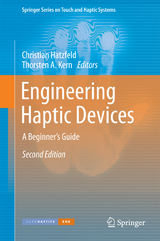Engineering Haptic Devices
A Beginner's Guide for Engineers
Seiten
2009
|
2009
Springer Berlin (Verlag)
978-3-540-88247-3 (ISBN)
Springer Berlin (Verlag)
978-3-540-88247-3 (ISBN)
- Titel erscheint in neuer Auflage
- Artikel merken
Zu diesem Artikel existiert eine Nachauflage
This book provides the first introduction into the wide area of haptic engineering. It covers all issues important for the design of haptic displays and the emphasis is put on technologies to artificially manipulate our haptic perception.
Tactile perception and haptics are essential for us, as we gain information about structures and surface properties of physical objects by using the sense of touch. Haptics also enables us to manipulate the physical world. The emphasis of this book is put on technologies for artificially deceiving our haptic perception.
First, examples and a definition of haptics from a physiological point of view are given. Thereby, one focus is on cases of loss of haptics in everyday professional routine, in order to emphasize the impact of haptics. Then, an overview of products with extraordinary haptic properties leads to a more precise terminology. In the second part of the book, concrete technical aspects of haptic manipulation and manipulators are considered beginning with higher-level subjects like control and kinematics and proceeding with a detailed discussion of actuators and sensors and the interfaces to and from the mechanical environment. In the final chapter fundamental software engineering is introduced, including haptic interaction in virtual reality simulations. "Engineering Haptic Devices" is intended to be a reference book for technologies of haptic relevance as well as a textbook on methods of haptic engineering and applications.It is addressed to students and professionals of engineering disciplines or natural sciences.
Tactile perception and haptics are essential for us, as we gain information about structures and surface properties of physical objects by using the sense of touch. Haptics also enables us to manipulate the physical world. The emphasis of this book is put on technologies for artificially deceiving our haptic perception.
First, examples and a definition of haptics from a physiological point of view are given. Thereby, one focus is on cases of loss of haptics in everyday professional routine, in order to emphasize the impact of haptics. Then, an overview of products with extraordinary haptic properties leads to a more precise terminology. In the second part of the book, concrete technical aspects of haptic manipulation and manipulators are considered beginning with higher-level subjects like control and kinematics and proceeding with a detailed discussion of actuators and sensors and the interfaces to and from the mechanical environment. In the final chapter fundamental software engineering is introduced, including haptic interaction in virtual reality simulations. "Engineering Haptic Devices" is intended to be a reference book for technologies of haptic relevance as well as a textbook on methods of haptic engineering and applications.It is addressed to students and professionals of engineering disciplines or natural sciences.
I Some Basics of Haptics.- Motivation and Application of Haptic Systems.- Terminology.- Biological Basics of Haptic Perception.- Modeling the User.- Internal Structure of Haptic Systems.- II Designing Haptic Systems.- Identification of Requirements.- Control of Haptic Systems.- Kinematic Design.- Actuator Design.- Force Sensor Design.- Application of Positioning Sensors.- Interface Selection.- Software Design.- Final Remarks on the Design of Haptic Systems.- III Appendix.- URLs.- Mechanical Impedances and Admittances for Translatory and Rotatory Systems.- Details about Gyrators and Transformers.- Impedance Values of Grasps.
| Erscheint lt. Verlag | 28.7.2009 |
|---|---|
| Zusatzinfo | XXXII, 472 p. 298 illus. |
| Verlagsort | Berlin |
| Sprache | englisch |
| Maße | 155 x 235 mm |
| Gewicht | 880 g |
| Themenwelt | Medizin / Pharmazie ► Physiotherapie / Ergotherapie ► Orthopädie |
| Technik | |
| Schlagworte | Control • Display • Haptic Displays • haptic Perception • Haptics • programmable logic controller • Sensor • sensors • Simulation • Tactile Sense • Tasten • Virtual Reality |
| ISBN-10 | 3-540-88247-2 / 3540882472 |
| ISBN-13 | 978-3-540-88247-3 / 9783540882473 |
| Zustand | Neuware |
| Informationen gemäß Produktsicherheitsverordnung (GPSR) | |
| Haben Sie eine Frage zum Produkt? |
Mehr entdecken
aus dem Bereich
aus dem Bereich
Spiraldynamik - programmierte Therapie für konkrete Resultate
Buch | Hardcover (2021)
Thieme (Verlag)
105,00 €





